Dwyre Crew – Assigned 754th Squadron – July 20, 1944
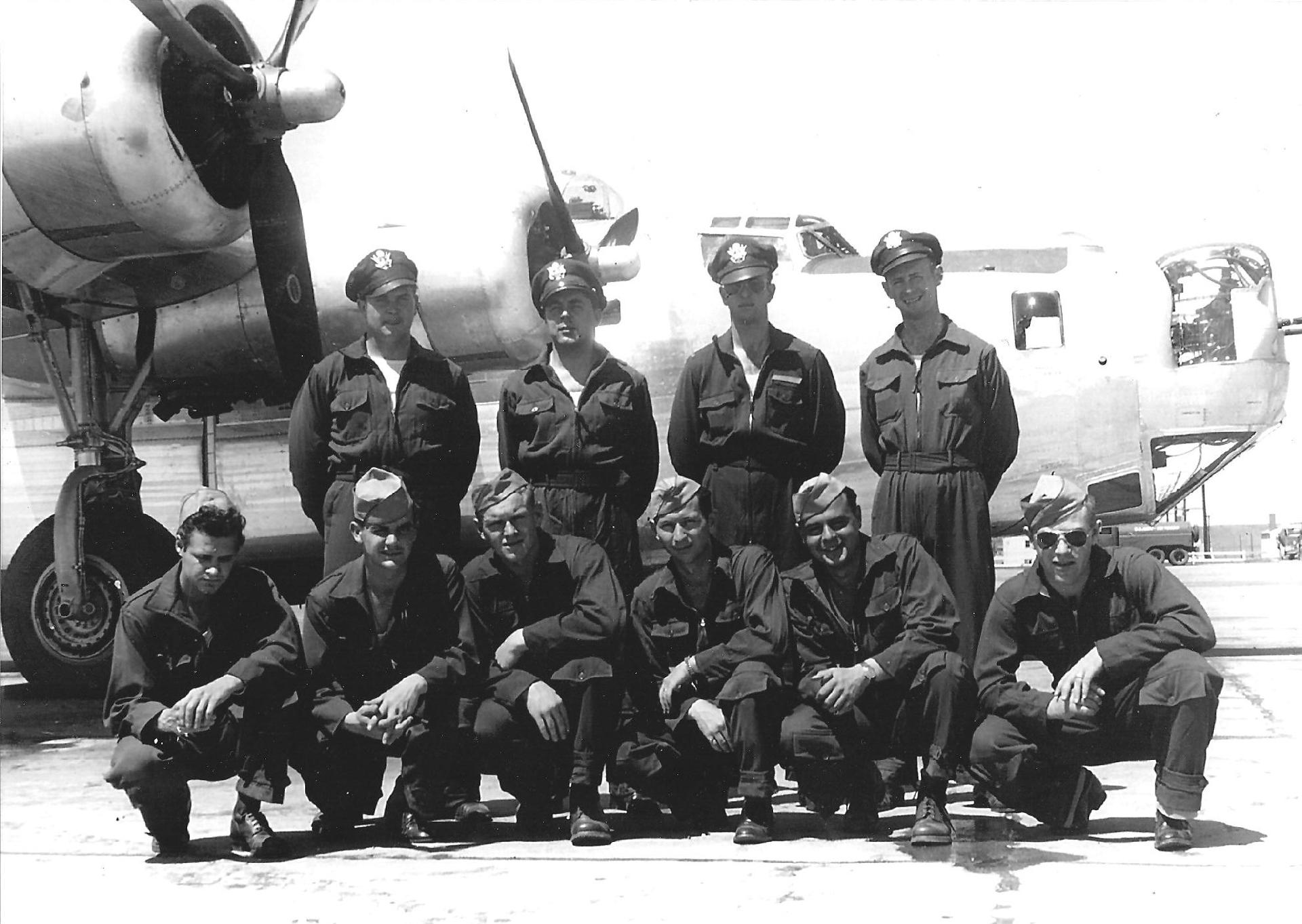
(Photo: Joe Flach)
Completed Tour
| Rank | Name | Serial # | Crew Position | Date | Status | Comments |
|---|---|---|---|---|---|---|
| 1Lt | George T Dwyre | 0818506 | Pilot | 14-Feb-45 | CT | MISSION LIST - Magdeburg |
| 1Lt | Hugh C DeVaney | 0829183 | Co-pilot | 16-Jan-45 | CT | Mission Load List |
| 1Lt | Burnell S Jones | 0814328 | Navigator | 06-Mar-45 | CT | Suspended fr flying UP AAF Reg 35-16 |
| 1Lt | Gaston R Feller | 0717047 | Bombardier | 23-Oct-44 | CT | Trsf to 755th - Lockridge Crew |
| T/Sgt | Freeman H Estes | 19136555 | Radio Operator | 16-Jan-45 | CT | Mission Load List |
| S/Sgt | Joseph L Flach | 32452837 | Flight Engineer | 16-Jan-45 | CT | Mission Load List |
| S/Sgt | Edgar K Call | 39915449 | Armorer-Gunner | 16-Jan-45 | CT | Mission Load List |
| S/Sgt | Arthur D Dorvee, Jr | 32943437 | Aerial Gunner | 16-Jan-45 | CT | Mission Load List |
| S/Sgt | William A Duggan | 37677346 | Aerial Gunner | 16-Jan-45 | CT | Mission Load List |
| S/Sgt | Shelby S Murray, Jr | 18098499 | Aerial Gunner | 16-Jan-45 | CT | Mission Load List |
2Lt George T. Dwyre and crew were assigned to the 754th Squadron on July 20, 1944. Their first mission, on July 31st, indicated a hasty indoctrination period after arriving at Horsham St. Faith, something that later crews would be allowed at least two weeks to accomplish. Their first mission to Ludwigshafen was the group’s 99th combat mission flown. The group’s 100th to targets of opportunity in France would be flown the next day, one in which Dwyre also flew.
In the crew’s 35 missions flown, they flew no less than 21 different B-24’s belonging to the group. Spitten Kitten/Sky Tramp seemed to be one of their most often used with 8 missions completed in that aircraft. Most of the Liberators they took over the continent had more than 30 missions to their credit, while several had 50 or 60.
On October 23, 1944, Gaston Feller was transferred to the 755th BS, which on this date became the group’s lead squadron. He was listed on these orders with the 2Lt Charles L. Lockridge crew, and it is assumed that he flew several missions as a lead bombardier. He went on rest home leave in January 1945, and was transferred back to the 754th Squadron on March 8, 1945.
The crew completed their tour in February 1945, only turning back twice, once due to mechanical issues and once due to lack of oxygen for the navigator. There are two missions where Dwyre’s name appears on formation plans, but the crew was not given sortie credit. Records on hand do not show the reason for this, whether the crew was listed on the plans, but did not fly or if an abort took place. These occurred on October 12, and December 25, 1944.
Lt Dwyre, was unique among the 458th flyers, in that he was wounded at Pearl Harbor on December 7, 1941 when the Japanese attacked the U. S. Fleet at anchor, bringing America into the war. At the time he was a Sergeant serving at Hickam Field. [See below]
Missions
| Date | Target | 458th Msn | Pilot Msn | Serial | RCL | Sqdn | A/C Msn | A/C Name | Comments |
|---|---|---|---|---|---|---|---|---|---|
| 31-Jul-44 | LUDWIGSHAFEN | 99 | 1 | 41-29596 | R | Z5 | 32 | HELL'S ANGEL'S | |
| 01-Aug-44 | T.O.s FRANCE | 100 | 2 | 41-28682 | I | Z5 | 50 | UNKNOWN 003 | |
| 02-Aug-44 | 3 NO BALLS | 101 | 3 | 41-29596 | R | Z5 | 33 | HELL'S ANGEL'S | |
| 03-Aug-44 | 2 NO BALLS | 102 | 4 | 42-95108 | M | Z5 | 28 | ENVY OF 'EM ALL II | |
| 04-Aug-44 | ACHIET A/F | 104 | 5 | 42-95018 | J | Z5 | 31 | OLD DOC'S YACHT | |
| 07-Aug-44 | GHENT | 107 | 6 | 41-29342 | S | J3 | 38 | ROUGH RIDERS | PHOTO - Harold Armstrong |
| 09-Aug-44 | SAARBRUCKEN | 109 | ABT | 41-29276 | G | Z5 | -- | URGIN VIRGIN/The ROTTEN SOCK | ABORT #1, 4 GENS |
| 11-Aug-44 | STRASBOURG | 110 | 7 | 41-28682 | I | Z5 | 52 | UNKNOWN 003 | |
| 13-Aug-44 | LIEUREY | 112 | 8 | 42-95018 | J | Z5 | 36 | OLD DOC'S YACHT | |
| 14-Aug-44 | DOLE/TAVAUX | 113 | 9 | 41-29596 | R | Z5 | 43 | HELL'S ANGEL'S | |
| 15-Aug-44 | VECHTA | 114 | 10 | 42-110184 | F | J3 | 20 | GWEN | |
| 16-Aug-44 | MAGDEBURG | 115 | 11 | 42-51110 | P | Z5 | 35 | TOP O' THE MARK | |
| 24-Aug-44 | HANNOVER | 117 | 12 | 42-95165 | S | Z5 | 31 | COOKIE | |
| 01-Sep-44 | PFAFFENHOFFEN | ABN | -- | 41-28705 | W | J4 | -- | YE OLDE HELLGATE | ABANDONED |
| 08-Sep-44 | KARLSRUHE | 123 | 13 | 44-40126 | L | Z5 | 23 | SPITTEN KITTEN / SKY TRAMP | |
| 18-Sep-44 | HSF to CLASTRES | TR02 | -- | 42-94975 | M | 754 | T1 | NOT 458TH SHIP | LOAD No. 3 (1545GAL) |
| 19-Sep-44 | HSF to CLASTRES | TR03 | -- | 42-94975 | M | 754 | T2 | NOT 458TH SHIP | TRUCKIN' MISSION |
| 21-Sep-44 | HSF to LILLE | TR05 | -- | 42-94975 | M | 754 | T3 | NOT 458TH SHIP | TRUCKIN' MISSION |
| 23-Sep-44 | HSF to ST DIZIER | TR07 | -- | 42-28739 | D | T1 | NOT 458TH SHIP - HETHEL | TRUCKIN' MISSION | |
| 25-Sep-44 | HSF to LILLE | TR08-1 | -- | 42-94975 | M | 754 | T4 | NOT 458TH SHIP | 1ST FLIGHT |
| 26-Sep-44 | HSF to LILLE | TR09 | -- | 42-52296 | E | T3 | NOT 458TH SHIP - HETHEL | SHIP #059? | |
| 27-Sep-44 | HSF to LILLE | TR10 | -- | 42-110059 | T | 754 | T3 | NO NAME or NAME UNKNOWN | BOWERS CROSSED OUT |
| 28-Sep-44 | HSF to LILLE | TR11 | -- | 42-110059 | T | 754 | T4 | NO NAME or NAME UNKNOWN | TRUCKIN' MISSION |
| 28-Sep-44 | HSF to LILLE | TR11 | -- | 42-52455 | O | 753 | T8 | PLUTOCRAT | WALKER CROSSED OUT |
| 29-Sep-44 | HSF to LILLE | TR12 | -- | 42-52296 | E | T8 | NOT 458TH SHIP - HETHEL | TRUCKIN' MISSION | |
| 30-Sep-44 | HSF to LILLE | TR13 | -- | 42-52296 | E | T9 | NOT 458TH SHIP - HETHEL | TRUCKIN' MISSION | |
| 03-Oct-44 | GAGGENAU | 127 | 14 | 42-110070 | K | Z5 | 35 | ELMER | |
| 07-Oct-44 | MAGDEBURG | 130 | ABT | 42-100366 | H | Z5 | -- | MIZPAH | NAV UNCONSCIOUS |
| 12-Oct-44 | OSNABRUCK | 132 | ANA | 44-40134 | R | J4 | 24 | UNKNOWN 039 | A/C NOT ATTKG |
| 19-Oct-44 | MAINZ | 136 | 15 | 42-95018 | J | Z5 | 50 | OLD DOC'S YACHT | |
| 26-Oct-44 | MINDEN | 138 | 16 | 42-95183 | U | Z5 | 50 | BRINEY MARLIN | |
| 09-Nov-44 | METZ AREA | 145 | 17 | 42-51179 | P | Z5 | 47 | DUSTY'S DOUBLE TROUBLE | SEE OPS REC |
| 10-Nov-44 | HANAU A/F | 146 | 18 | 42-95018 | J | Z5 | 55 | OLD DOC'S YACHT | |
| 16-Nov-44 | ESCHWEILER | 147 | 19 | 44-40475 | D | 7V | 12 | JOLLY ROGER | |
| 30-Nov-44 | HOMBURG | 151 | 20 | -- | -- | -- | -- | No FC - Sqdn Rec's | |
| 10-Dec-44 | BINGEN | 154 | 21 | 42-110059 | T | Z5 | 50 | UNKNOWN 056 | 2 BD SPARE |
| 18-Dec-44 | KOBLENZ | REC | -- | 42-51196 | Q | J3 | -- | THE GYPSY QUEEN | RECALL DUTCH ISLE |
| 24-Dec-44 | SCHONECKEN | 157 | 22 | 44-40126 | L | Z5 | 32 | SPITTEN KITTEN / SKY TRAMP | |
| 25-Dec-44 | PRONSFELD | 158 | -- | 42-95018 | J | Z5 | 62 | OLD DOC'S YACHT | |
| 27-Dec-44 | NEUNKIRCHEN | 159 | 23 | 44-40126 | L | Z5 | 34 | SPITTEN KITTEN / SKY TRAMP | |
| 30-Dec-44 | NEUWIED | 161 | 24 | 44-40126 | L | Z5 | 36 | SPITTEN KITTEN / SKY TRAMP | |
| 01-Jan-45 | KOBLENZ | 163 | 25 | 44-40126 | L | Z5 | 38 | SPITTEN KITTEN / SKY TRAMP | |
| 02-Jan-45 | REMAGEN | 164 | 26 | 42-95183 | U | Z5 | 69 | BRINEY MARLIN | |
| 08-Jan-45 | STADTKYLL | 167 | 27 | 42-95120 | M | Z5 | 62 | HOOKEM COW / BETTY | LANDED OFF LOCATION |
| 10-Jan-45 | SCHONBERG | 168 | 28 | 42-95120 | M | Z5 | 63 | HOOKEM COW / BETTY | |
| 14-Jan-45 | HALLENDORF | 170 | 29 | 42-95120 | M | Z5 | 64 | HOOKEM COW / BETTY | |
| 16-Jan-45 | MAGDEBURG | 171 | 30 | 42-95120 | M | Z5 | -- | HOOKEM COW / BETTY | #4 ENGINE (SEE RPT) |
| 31-Jan-45 | BRUNSWICK | 176 | 31 | 42-51196 | Q | J3 | 31 | THE GYPSY QUEEN | RECALL - SORTIE CREDIT |
| 03-Feb-45 | MAGDEBURG | 177 | 32 | 41-29305 | N | Z5 | 45 | I'LL BE BACK/HYPOCHONDRIAC | |
| 06-Feb-45 | MAGDEBURG | 178 | 33 | 44-40126 | L | Z5 | 49 | SPITTEN KITTEN / SKY TRAMP | |
| 08-Feb-45 | RHEINE M/Y, OSNABRUCK | REC | -- | 44-40126 | L | Z5 | -- | SPITTEN KITTEN / SKY TRAMP | RECALL - WEATHER |
| 09-Feb-45 | MAGDEBURG | 179 | 34 | 44-40126 | L | Z5 | 50 | SPITTEN KITTEN / SKY TRAMP | |
| 14-Feb-45 | MAGDEBURG | 181 | 35 | 44-40126 | L | Z5 | 51 | SPITTEN KITTEN / SKY TRAMP |
Lt Burnell S. Jones – Navigator

On the mission of October 7, 1944 the 458th’s target was the Rothensee Oil Factory near Magdeburg, Germany. The Dwyre crew was assigned B-24H 42-100366, an original 754th Squadron ship named Mizpah.
According to the group’s report on aircraft not attacking: “Early in the mission, navigator began complaining of slight sickness. Pilot kept continual check on him during flight until funally he was unable to receive a reply. Bombardier checked and found him unconscious. Full rich oxygen failed to bring a response and A/C (aircraft) returned. Navigator is now confined to quarters with fever.”
As things turned out, the crew would have plenty of chances to “visit” Magdeburg – five times in a one-month period, four of these consecutively to complete their tour!
As related to Kevin McKenzie… He told me about the Ludwigshaven mission yesterday… it was so early in his time he was still learning… he wondered why the .50 cal rounds were packed as they were on both sides of his position, i.e. the rounds to his left stacked facing left (toward exterior of plane skin) and the rounds on his right stacked pointing right (toward plane skin ext.).
Said they caught a big round of flak up through the belly and the .50 cal. rounds started cooking off. Scared the s_ _t out of him (this is a Christian man)!! So as he’s manually cranking open the nose gear doors to dump ammo, the rounds are going off OUTWARD thru the skin of the plane… on landing he said they had a couple hundred holes both sides. AND he found on the floor the piece of flak wrapped around by a half-spent .50 cal round that he believed started the whole shebang. It had fused into one piece… he gave it to his son, who presumably still has it (along with his orig. 35-mission A-2 jacket).
At the tour’s start, they were briefed by the English on the visuals of flak bursts and how to gauge the intensity thereof for debriefing purposes… after the Ludwigshaven mission he said (while having their round of whisky that every crew got upon walking into debriefing!!) another flight’s crewmember asked “Do you think that was heavy flak or light flak on today’s mission?” Burnell said he responded, “Probably it was light flak.” To which the other crewman said “Hell, if that was light flak I NEVER want to see heavy flak!” Burnell said that each A/C (Aircraft Commander) “signed for” a round of 2 oz. whisky per crewman upon each landing. It was optional depending upon each man… if the day’s run wasn’t too harrowing the Capt. (or A/C) would sign anyway for the bottle and the crews would stockpile the whisky and have a party!

Display case created for Mr. Jones by Kevin McKenzie
2Lt George T. Dwyre – Pearl Harbor Survivor
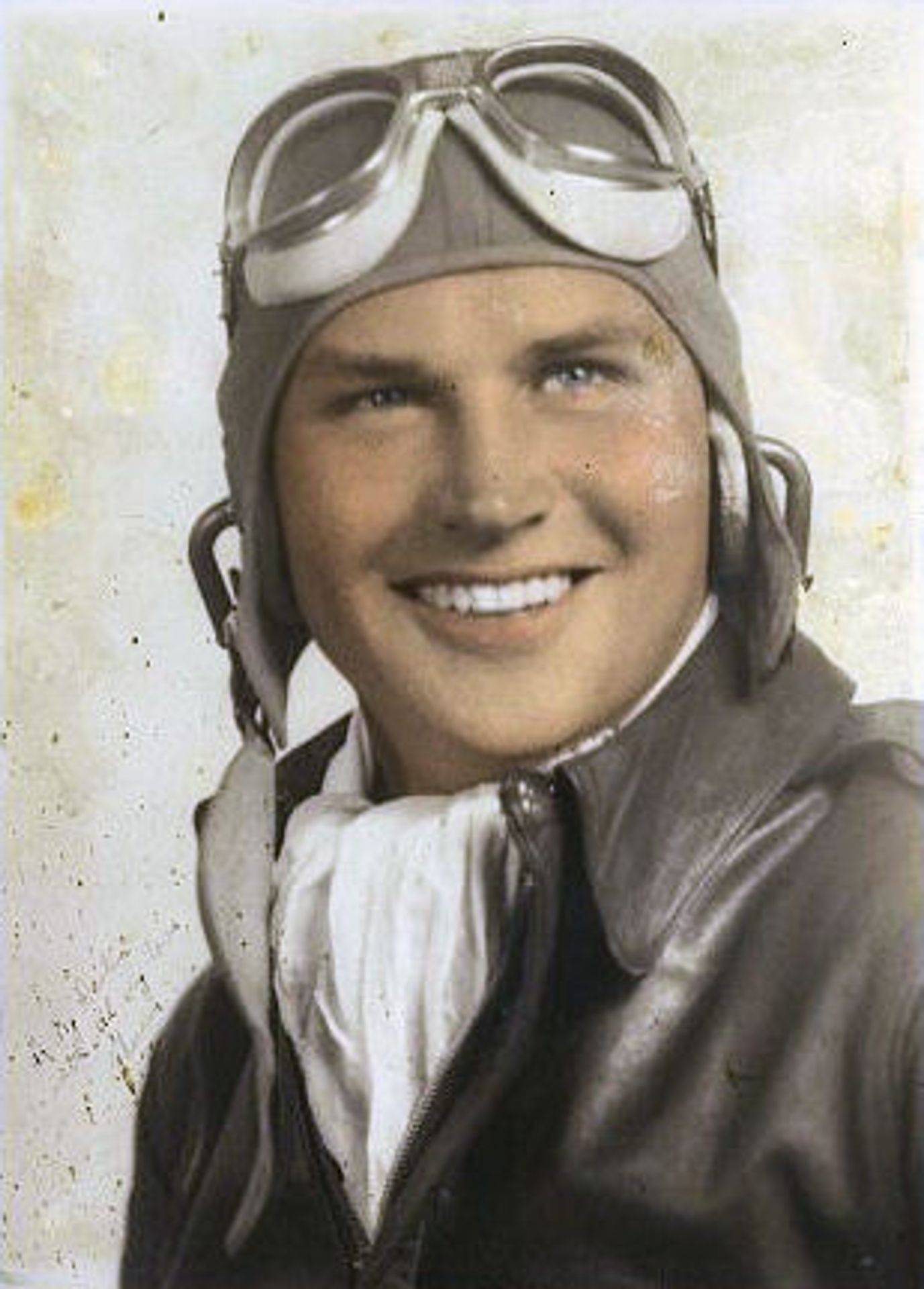
Left: Flight Officer George Thurman (“Thurm”) Dwyre 1942 (age 23)
Born November 16, 1919, Thurm grew up in a small Midwest town of 4,800, Spring Valley, Illinois. The son of a carpenter and a music teacher he was raised in the height of the depression when most American families were forced to live at the poverty level and survived with hard work, eating from their own backyard gardens, making their own clothes or mending and altering clothes from one sibling to the next. Upon graduation from Hall Township High School (class of 1936) his family was too poor to take advantage of the college scholarships so he chose to enlist in the Army.
He enlisted in the Army when he was 19 years old on November 1, 1939. He enlisted about the same time as four of his Spring Valley buddies enlisted. They were issued uniforms, given short orientation and then off to Honolulu and Hickam Field. As an army Private his pay was $21 a month and he was able to send money back home.
Meanwhile a beautiful redheaded girl, Leslie Barbara Lane, was raised and schooled in Honolulu had finished her studies at Roosevelt High School and was promoted as a supervisor with the Honolulu Mutual Telephone Company. Thurm and Leslie met, fell in love and were engaged to be married in the summer of 1942. They were married 62 years before her death in 2004.
Both of them were in Honolulu Hawaii when the Japanese attacked Hawaii on December 7, 1941. Both of them were called to serve their country because of the December 7th attack and both proudly served side by side for more than 33 years.
“The wing of my barracks was on the south side, second floor, and across the street from the hangar line and offered a full view of the entire area. I was in our barracks, getting ready to join some friends for a beach party. It was 7:55 a.m. Suddenly, Japanese aircraft were strafing and bombing the entire hangar line – hangars and planes. The noise of the exploding bombs and machine gun fire was deafening and drew my attention to the hangars and aircraft that were parked less than 100 yards from my position. I saw the red dot markings on Japanese aircraft wings as they made their turn off the low level bomb run. One B-18, parked in an open space between two hangars, was blown up with a direct hit as I watched. Many curious and confused airmen ran onto the open parade ground only to be strafed by the Japanese aircraft turning off their bomb run. Yet, at the same time, I saw angered and frustrated airmen throwing rocks at the enemy aircraft. Angered at the realization that war had come and frustrated that they did not have the weapons to fight back. The noise was unescapable, the scene was unforgettable and the damage unbelievable.”
-Col. Dwyre’s speech to the Veterans of Foreign Wars, St Petersberg, Florida 2006
Then a Sergeant, Thurm Dwyre located a stock of machine guns in a warehouse. He set up one .50 caliber machine gun, tested it and then had a private operate it while he and one of his buddies went back to the warehouse to get more weapons.
He was returning with another machine gun and ammunition when he saw six aircraft in formation approaching from the west – when he saw the bombs being released he shouted “HIT THE GROUND!!” They hugged the ground as bombs exploded around them. The concussion raised their bodies off the ground. He was hit by the shrapnel and driven to the hospital like so many others wounded in the attack. On the way to the hospital he was strafed by another plane and questioned whether or not he would survive.
When the attack started, as a telephone supervisor, Leslie was busy connecting the high ranking personnel with Washington, D.C. She recalls that a direct transpacific phone line to Washington, D.C. had been installed at least a week prior to the attack. The supervisors were also given a list of key personnel to be notified in case of an emergency. She remembered that the responses to the alert calls ranged from shock to disbelief. The disbelievers were told to look toward Pearl Harbor where they could see the smoke billowing from the destructive bombing at Pearl Harbor and Hickam Field.
Right: Wedding Day – January 1, 1942 – Honolulu, Hawaii
After Sergeant Dwyre recovered from his injuries, he and Leslie were married on January 1, 1942 while he was on a 2-hour pass – we were at war and the military was busy. Thereafter, Thurm and Leslie served together.
Thurm was assigned to gliders – he became an instructor. Then he was assigned to heavy bombers where he was the Aircraft Commander of the B-24 Liberator flying 35 missions over enemy territory in the European Theater. Leslie waited like so many wives of our sailors, soldiers and airmen in each of the wars where they are called to serve.
WWII ended with an unconditional surrender from our enemies, which meant freedom for the world thanks to Thurm and Leslie and so many others like them who gave unselfishly – some who gave their lives in service to the country they loved.
In his career Thurm served as: Officer’s Aircraft Maintenance with Training Commands; Director of Instrument Maintenance School; Contract Training Project (ATC); Advisor to the Chinese National Air Force in Formosa; Pentagon test programs for Atlas and Titan Missile Systems; Venezuela – Advisor to Venezuelan Air Force; Panama Canal Zone and served on the joint staff with Unified Command, Southern Command; Pentagon – assistance programs throughout Central and Latin America; USAF Headquarters in the Panama Canal Zone, Chief of Staff for Latin American Affairs; Deputy Chief of Staff of the United States Readiness Command at MacDill Air Force Base in Florida.

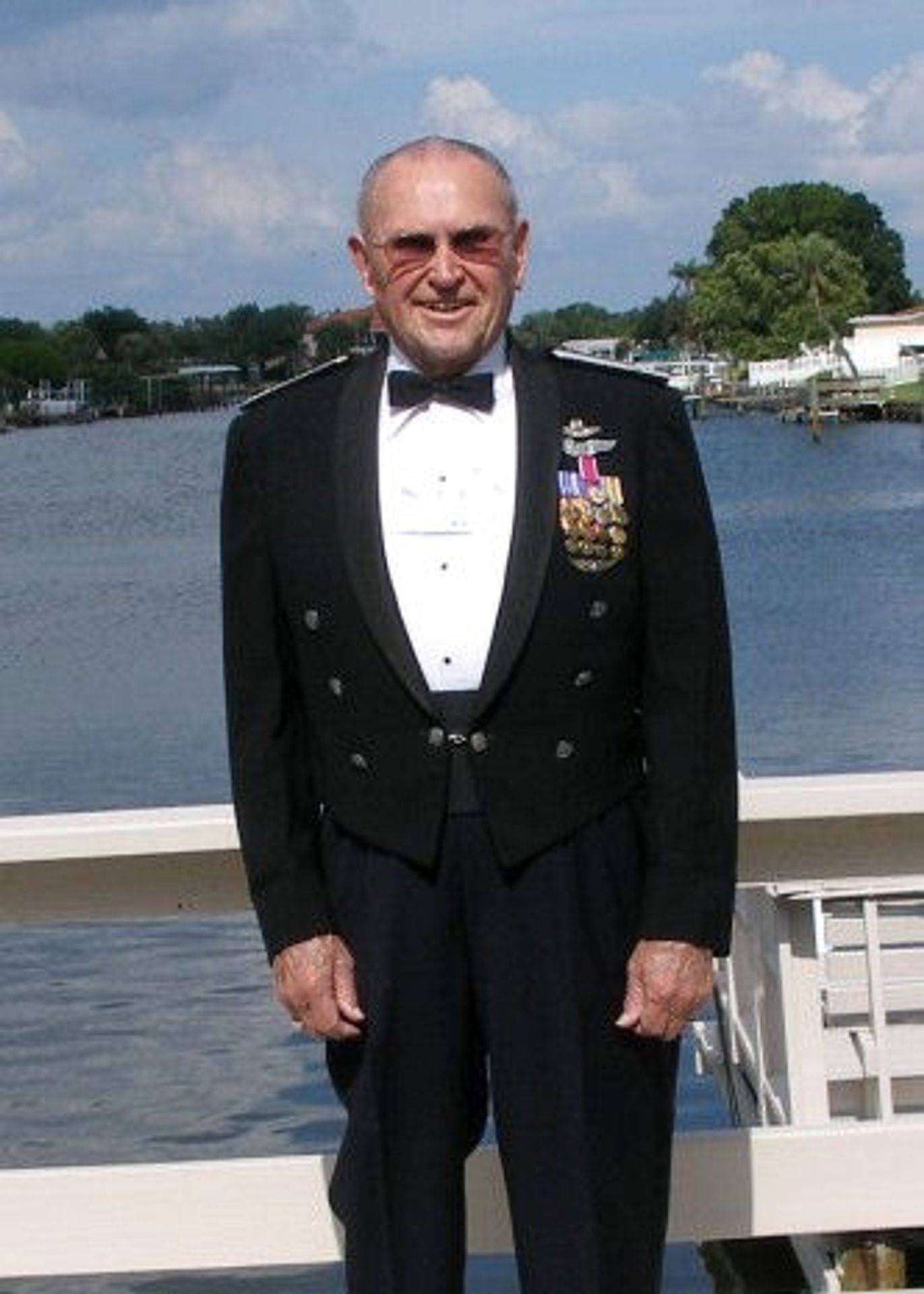
Col Dwyre – 2009 Military Officer’s Association (MOA) Ball
Thurm and Leslie retired June 1, 1973 after serving 33 years and 7 months.
Military Decorations Earned Legion of Merit, Distinguished Flying Cross, Purple Heart (for his wounds resulting from the Dec 7th attack), Air Medal with four oak leaf clusters, Meritorious Achievement Award, Good Conduct Medal, American Defense Service medal with a battle star verifying active duty at Pearl Harbor area during the attack of December 7th American Campaign, Asiatic-Pacific Campaign with one battle star (denoting the attack on Pearl Harbor) European-Africa-Middle East Campaign with five battle stars.
Two of the Greatest of What Has Been Called “America’s Greatest Generation”.
-Article and photographs from St Petersburg Times, St Petersburg, FL – submitted by John Dwyre, June 2010
August 7, 1944
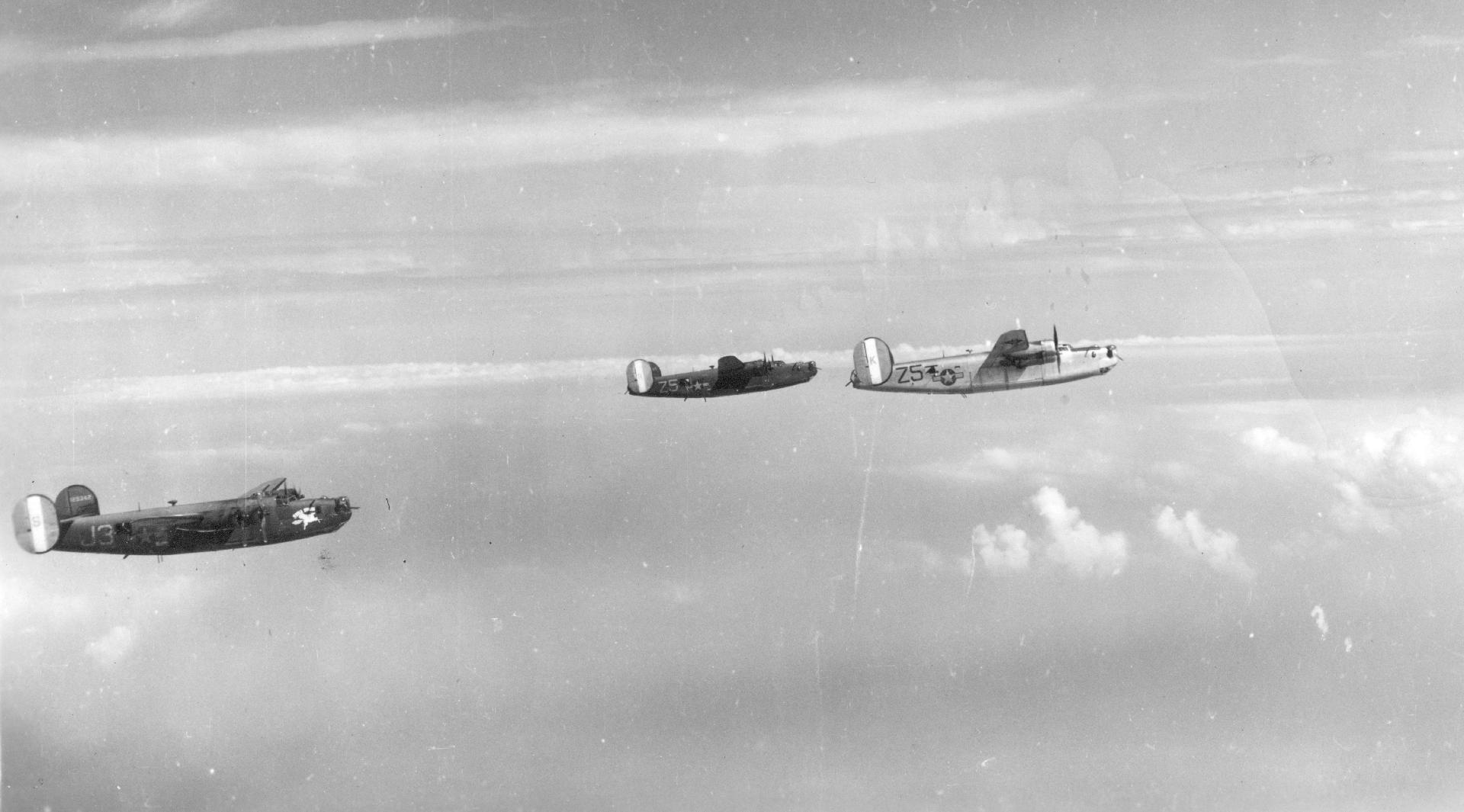
The Dwyre crew is shown here flying Rough Riders (left) along with Lt Barnhart in Hell’s Angel’s (center) and Dixie Belle flown by Lt Livermore (right).
This photo was taken by T/Sgt Harold R Armstrong, Flight Engineer on the 753rd Squadron crew of Lt Alvestad.
January 17, 1945
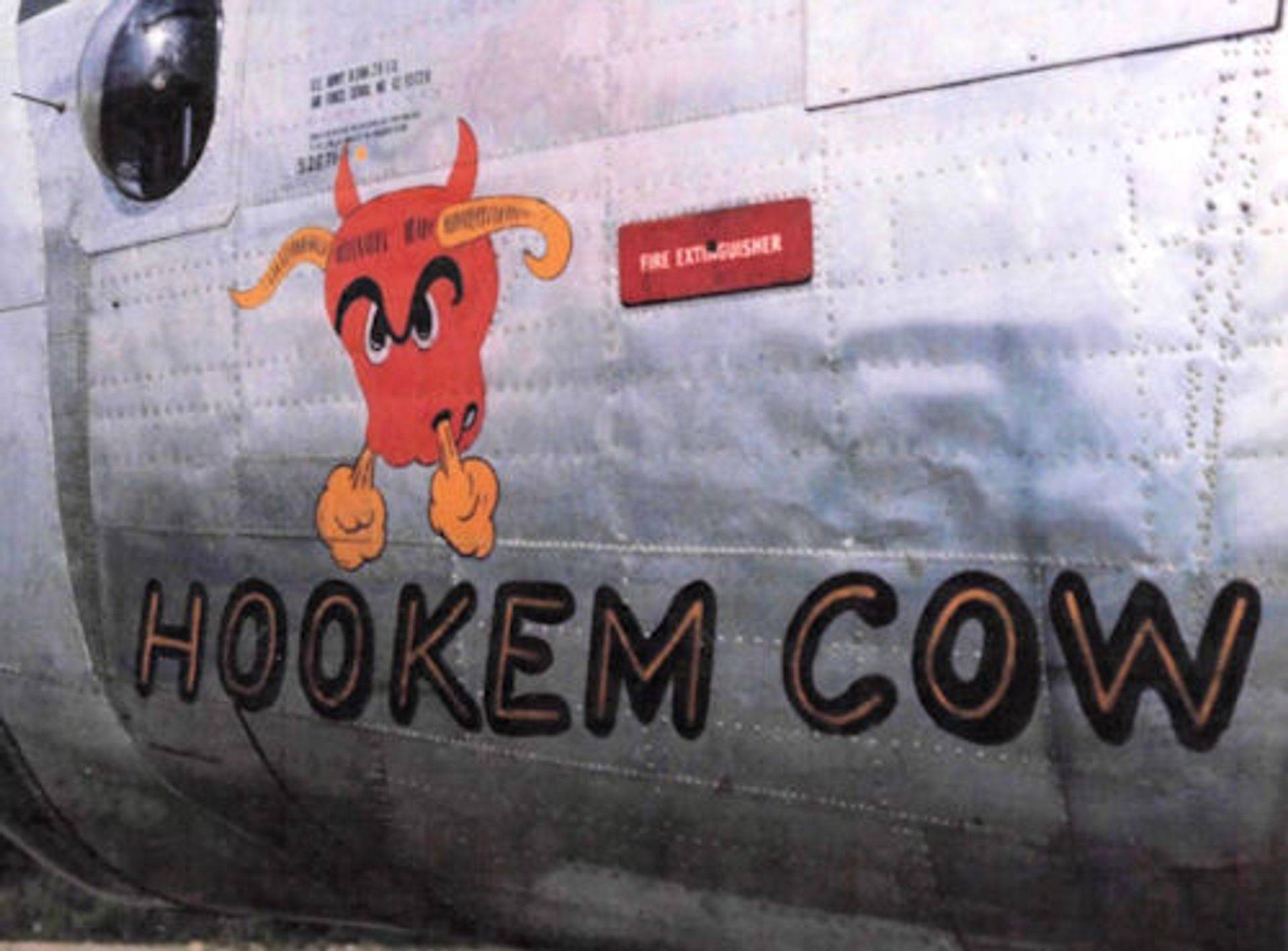
STATION SIDELIGHTS by Lt. Joiner
A CREW ON OUR STATION
When we take a look at the records, we see that we have some crews on the field who, because of cooperation among the crew have done some good jobs. Today we shall give you the poop on Lt George Dwyre’s crew who did a good job on yesterday’s mission. While on the mission and in enemy territory, they found the oil pressure on an engine dropping fast and knew that they would have to leave formation. Finding it impossible to keep up in position, they decided to return home alone, despite the fact bandits had been reported. Losing 500 feet a minute, it soon became obvious that they would have to drop their bombs and so they turned around and returned into Germany.
The nose gunner lined the pilot up on a German town and the Navigator, Lt Jones salvoed. When they got back to the base they found that the field was socked in, and after they had made six passes at the field, and with a feathered engine, they were able to land.
In talking to some of the crew members, it was obvious that they all agreed that Lt Dwyre had done an excellent job on the mission and that they owed their lives to his skill. Congratulations on having a fine crew, George, and having all that cooperation. It might be interesting to know who these men are and a few of their accomplishments before and after they entered the army. The pilot has been in the army for five years and was at one time a glider pilot.
He was at Pearl Harbor at the time of the ambush, and was wounded in the ____ island. Later on he was married there. In civilian life he managed a drug store. George hails from Spring Valley, IL. The Navigator is Lt Burnell Jones who also has been on the army for five years and was an enlisted bombardier on a B-17. While _____ he was given credit for sinking a submarine. Jones has really been around, having served in the South Pacific and the Canal Zone. Later on he was married to a Spanish girl from Puerto Rico. Jones comes from Gladewater, Texas.
The Radio Operator S/Sgt Freeman Estes, has been in service three years, was ____ at one time and attended radio school and gunnery school. While in civilian life, Estes was a construction engineer, having had charge of building the airfields on Midway, Wake, Johnston, and Palmyra Islands. He also was in charge of construction of fields on Islands in Hawaii and Alaska. He is now awaiting a commission in the Army Engineers. The other members of the crew are T/Sgt Joseph Flach, S/Sgt Shelby Murray, S/Sgt Arthur Dorvee, S/Sgt Edgar Call, S/Sgt William Duggan, and we forgot, we apologize, Lt Hugh DeVany, the Co-Pilot. These boys are in the 754th Sq and from this we can see that they are an outstanding crew. All the best of luck to you fellows.
This article relating to the crew‘s participation in the mission of January 16, 1945, was found in the 458th microfilmed records and reproduced here as best as possible.
